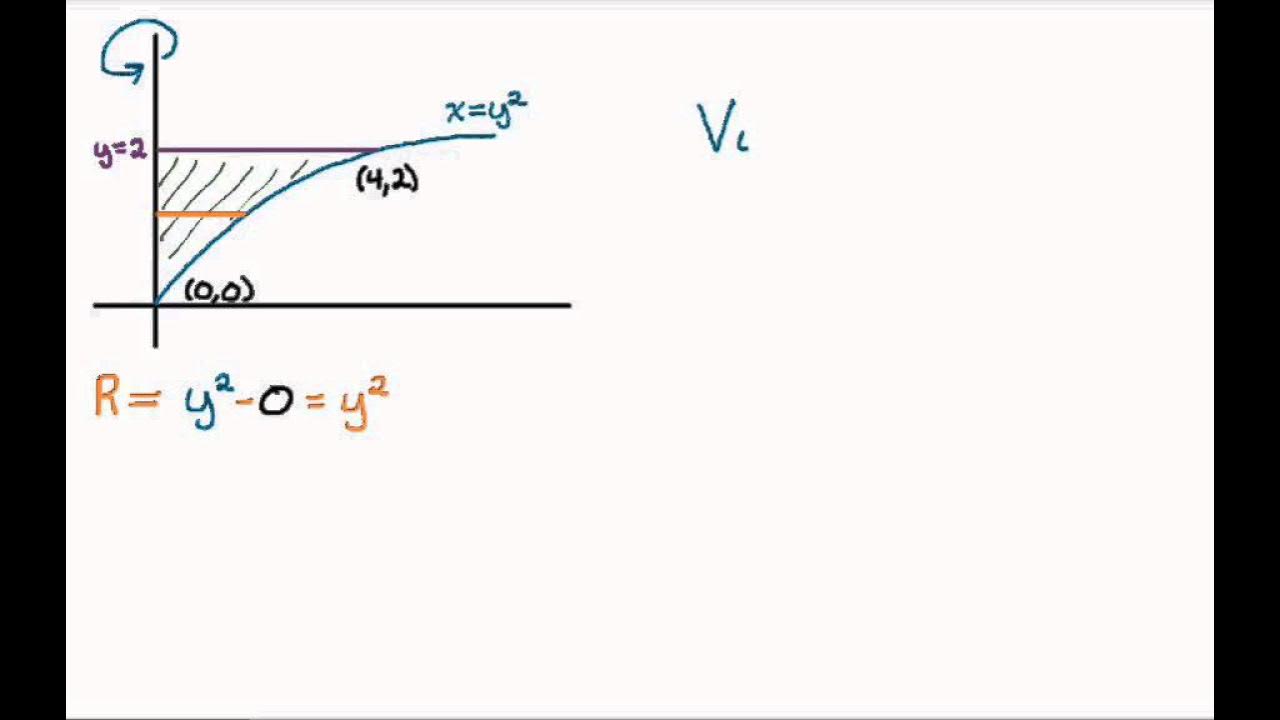Volumes with Known Cross Sections with Calculus, pg 3, pt 1
TLDRThe video script is a detailed walkthrough of calculating the volume of a known region using cross-sectional methods. The presenter begins by addressing the common apprehension students have when tackling such problems, emphasizing the importance of a calm approach. The region in question is in the first quadrant, bounded by a specific function. The presenter calculates the x-intercept and sets up integrals for the area of the region, using both x and y as variables. The process involves finding the area under the curve of a function from a given lower limit to an upper limit, and then transforming this into an integral in terms of y to solve for the volume. The presenter makes several attempts, including solving for x in terms of y, and correcting mistakes along the way. The video concludes with the presenter successfully calculating the area and providing insights into the process, encouraging viewers not to be intimidated by such problems and to approach them with confidence.
Takeaways
- 📚 The discussion is focused on calculating the volume of a known region using cross sections, such as semicircles, equilateral triangles, or squares.
- 🧮 The general approach involves integrating the area of a cross section from point a to b, often involving expressions like \( s^2 \) times a function of \( s \).
- 😌 The speaker advises to stay calm and realize what you're doing to avoid making the problem-solving process more difficult.
- 🏢 The region in question is bounded in the first quadrant by certain curves, and the x-intercept is determined by setting the function equal to zero.
- 📈 Two integrals are set up, one in terms of x and the other in terms of y, to calculate the area of the region.
- 🔍 The x-intercept is found by solving \( e^{x+1} + 1 = 5 \), which leads to \( x + 1 = \ln(5) \) and hence \( x = \ln(5) - 1 \).
- 🤔 The speaker acknowledges making a mistake in the process and emphasizes the importance of a good attitude and approach to problem-solving.
- 📐 For the area calculation in terms of y, the function \( g(y) \) is defined as \( \ln(5(y+1)) - 1 \), which helps in setting up the integral.
- 🔢 The area is calculated using a calculator, with the integral from \( \ln(5) - 1 \) to 2 for the top curve and from 0 to \( e^3/5 - 1 \) for the bottom curve.
- 📉 The process involves setting up integrals for the area under curves and solving them, which can be challenging but is made easier with a clear understanding.
- 💡 The key to solving these types of problems is not to be intimidated, to understand the process, and to apply it methodically.
Q & A
What is the topic of discussion on page three, notes 21 of calculate b?
-The topic is about calculating the volume of known cross sections using integral calculus.
What is the general approach when calculating the volume of a region with a given base and cross sections?
-The general approach is to perform an integral from 'a' to 'b' of the area of a cross section, often represented as s squared times a function of s, where 's' represents a segment parallel or perpendicular to the y-axis.
What is the first step in setting up an integral for the area of a region bounded by certain curves?
-The first step is to identify the x-intercepts of the curves bounding the region in the first quadrant.
What is the function f(x) mentioned in the transcript?
-The function f(x) is one fifth e to the power of (x plus one) minus one.
How does the speaker determine the x-intercept of the function f(x)?
-The speaker sets f(x) equal to zero and solves for x, which gives x plus one equals the natural log of five, and then x equals the natural log of five minus one.
What is the integral setup for calculating the area of the region in terms of x?
-The integral is set up from the natural log of 5 minus one to two of the function f(x) with respect to x (f(x) dx).
How does the speaker attempt to calculate the area in terms of y?
-The speaker solves the function for x in terms of y, which gives x as the natural log of five times (y plus one) minus one, and then sets up an integral from 0 to e cubed over five minus one of the right-hand curve minus the left-hand curve with respect to y (dy).
What is the mistake the speaker makes when setting up the integral in terms of y?
-The speaker incorrectly includes a minus sign in the integral and forgets to use parentheses correctly, leading to an incorrect setup of the integral.
What is the correct approach to find the area in terms of y?
-The correct approach is to express the right-hand curve as 2 minus the left-hand curve in terms of y, and then integrate from 0 to e cubed over five minus one of this expression squared with respect to y (dy).
What is the importance of having a clear mindset when solving mathematical problems?
-Having a clear mindset is important because it prevents unnecessary stress and allows for a more straightforward approach to problem-solving, which can lead to more accurate results.
How does the speaker conclude the discussion on calculating the volume of the region?
-The speaker concludes by emphasizing the importance of not being intimidated by the problem, and by demonstrating that once the problem is approached in terms of y, it becomes more straightforward.
Outlines
📚 Calculating Volumes with Cross Sections
The speaker is discussing the calculation of the volume of a known region using cross sections. They explain that the region's base is defined and then semicircles, equilateral triangles, squares, etc., are built on top. The process involves integrating the area of the cross section from 'a' to 'b', usually represented as \( s^2 \) times a function of 's', where 's' is a segment along the top or bottom or perpendicular to the y-axis. The speaker advises the audience to stay calm and not to panic, as it's crucial for problem-solving. They then proceed to work through an example involving a region in the first quadrant bounded by a certain function, setting up integrals in terms of both 'x' and 'y' to find the area, and using a calculator to evaluate the results.
🧮 Solving for Area and Volume with Integrals
The speaker continues the discussion by focusing on calculating the area under a curve defined by a function \( f(x) \) from \( \ln(5) - 1 \) to 2. They mention making a mistake in setting up the integral and correct it by solving for 'x' in terms of 'y', which is essential for the next steps. The integral is then set up correctly, and the result is obtained using a calculator. The speaker emphasizes the importance of setting up the integral correctly and the process of finding the area in terms of 'y'. They also discuss the process of calculating the volume of a solid with cross sections that are semicircles, using the formula \( \pi \over 8 \) times the integral of \( s^2 \) from 0 to \( e^3 / 5 - 1 \), where \( s \) is the difference between the right and left-hand curves.
📐 Working with Isosceles Right Triangle Cross Sections
The speaker moves on to a different scenario where the cross sections perpendicular to the y-axis are isosceles right triangles. They explain that the area of such a triangle is one half the base times the height, and thus the volume can be found by integrating this area from 0 to \( e^3 / 5 - 1 \). The speaker uses the function \( s = 2 - g(y) \), where \( g(y) \) is defined as \( \ln(5)(y + 1) - 1 \), to set up the integral for the volume. They demonstrate the process of calculating the volume and mention the challenges faced, particularly with the area calculation. The speaker concludes by encouraging the audience not to be intimidated by such problems and to approach them with a positive attitude.
Mindmap
Keywords
💡Volume
💡Cross sections
💡Integral
💡Semicircles
💡Equilateral triangles
💡Squares
💡Perpendicular
💡Natural log
💡Calculator
💡Isosceles right triangles
💡Attitude
Highlights
Discusses calculating the volume of a known cross section using integral calculus.
Provides advice to stay calm and realize what you're doing to avoid getting overwhelmed.
Introduces the concept of building semicircles, equilateral triangles, squares, etc. on top of a base region.
Explains that the area of the cross section is often calculated as s^2 times a function of s.
Demonstrates setting up integrals in terms of both x and y to find the area of the region.
Shows how to find the x-intercept of the function f(x) = (1/5)e^(x+1) - 1.
Uses a calculator to evaluate the integral from the natural log of 5 - 1 to 2 of f(x).
Demonstrates solving for x in terms of y to set up the integral in terms of y.
Finds the intersection points of the curves to set the bounds for the integral in y.
Calculates the area under the top curve minus the bottom curve from 0 to e^(3/5) - 1.
Uses parentheses correctly to avoid errors in the integral expression.
Re-emphasizes the importance of not being intimidated by the problem and approaching it with a good attitude.
Discusses using cross sections perpendicular to the y-axis that are semicircles to find the volume.
Shows how to set up the integral for the volume using pi/8 times the integral of s^2 from 0 to e^(3/5) - 1.
Introduces a new solid with cross sections that are isosceles right triangles.
Calculates the volume as 1/2 times the integral of s^2 from 0 to e^(3/5) - 1, where s = 2 - g(y).
Reflects on the challenges faced during the problem-solving process and the importance of mindset.
Provides the final calculated volumes for the two different solids as 0.519 and 0.660 respectively.
Transcripts
Browse More Related Video
5.0 / 5 (0 votes)
Thanks for rating:





